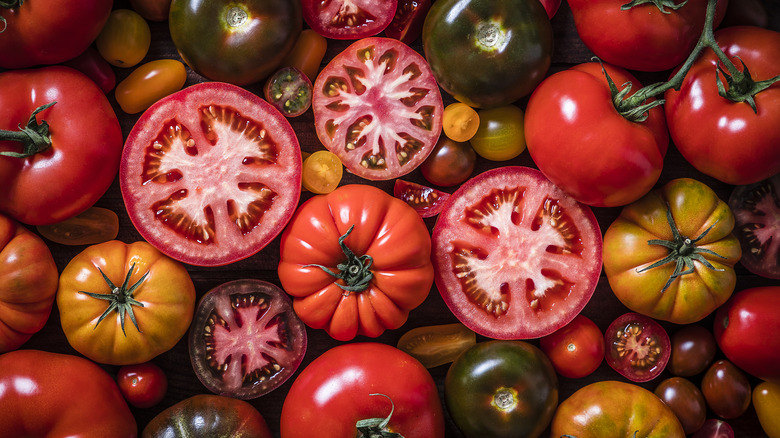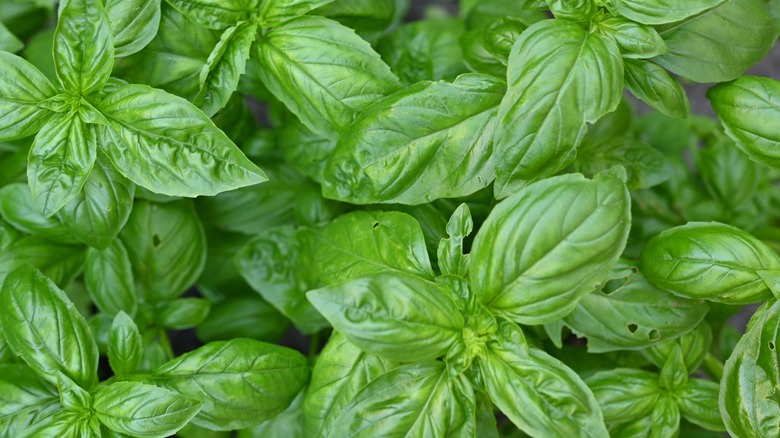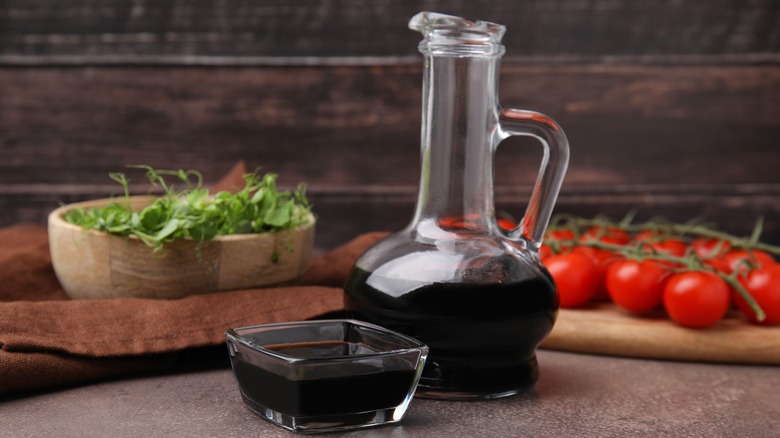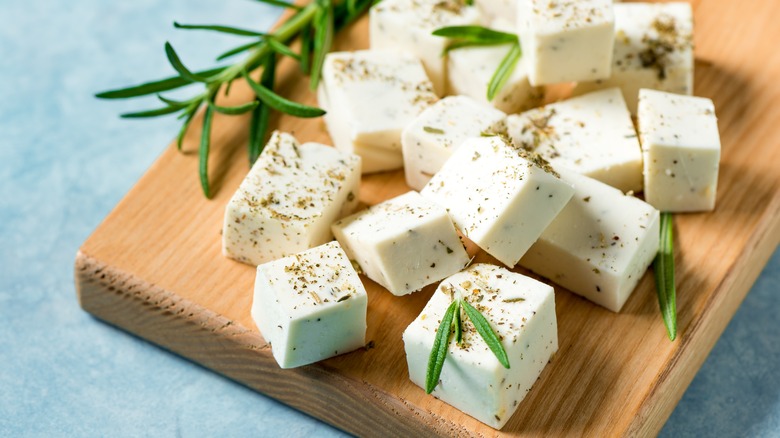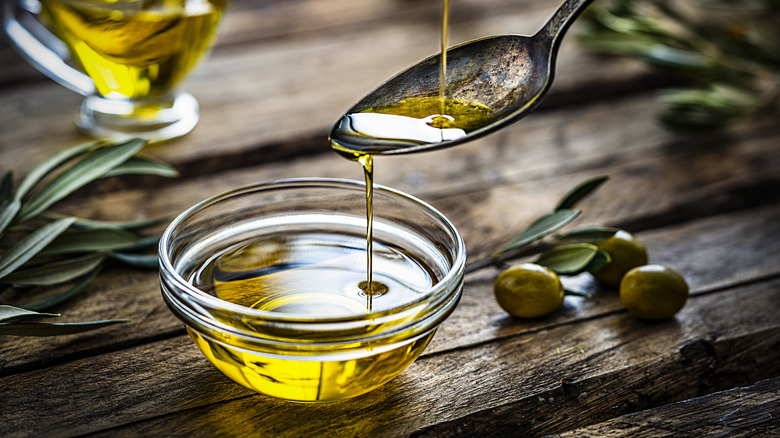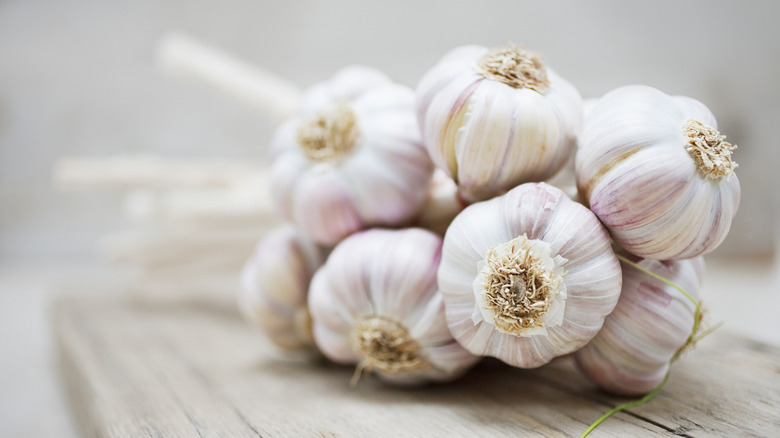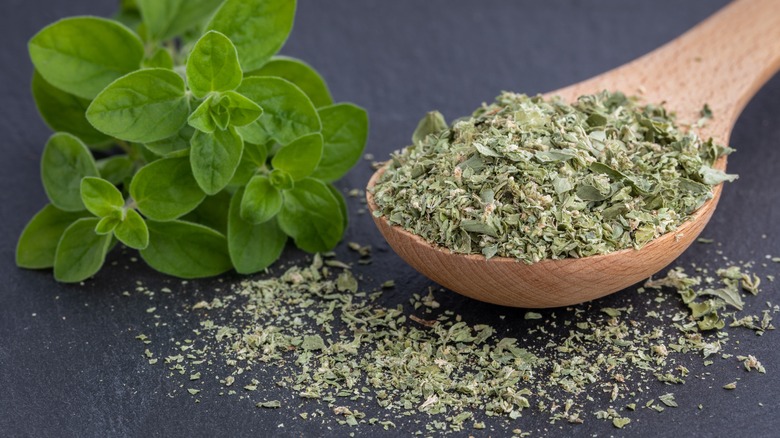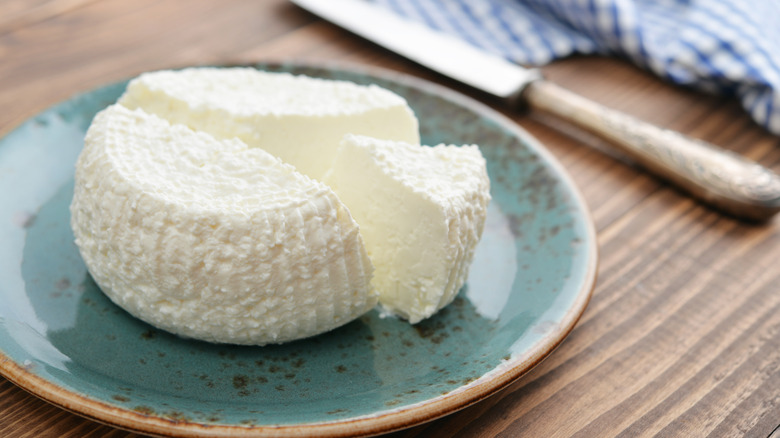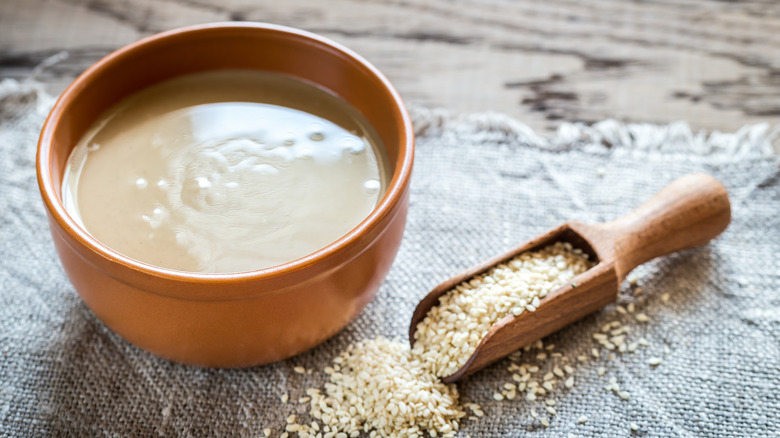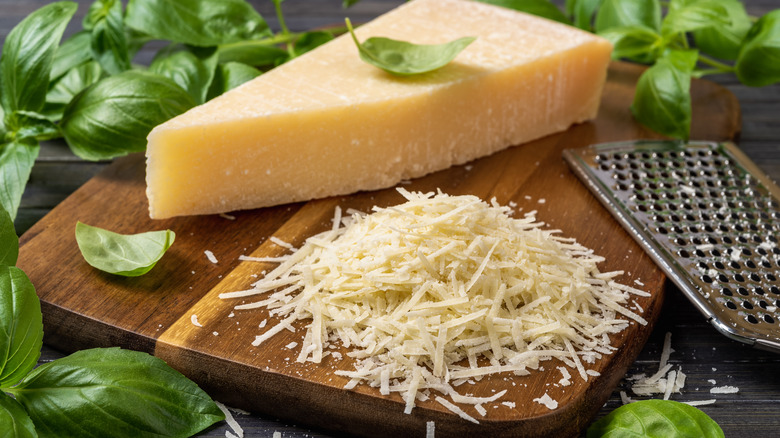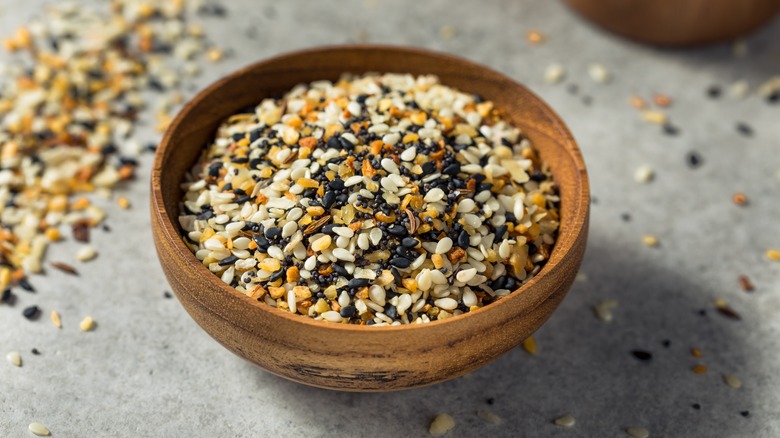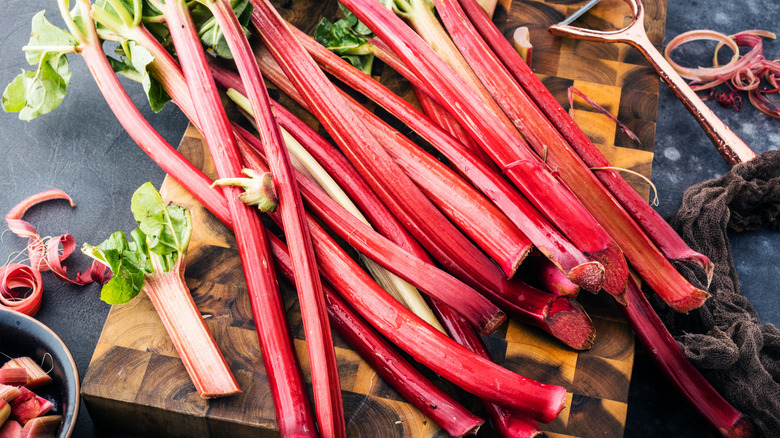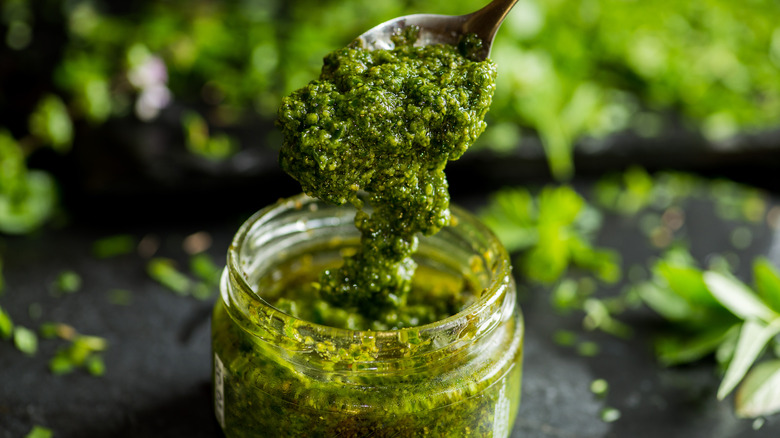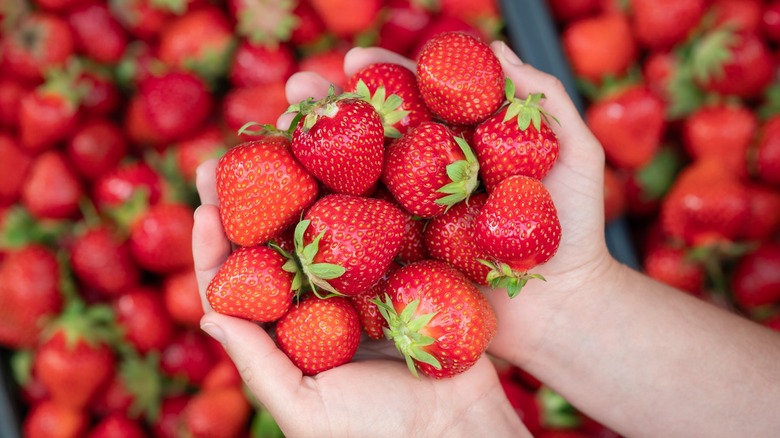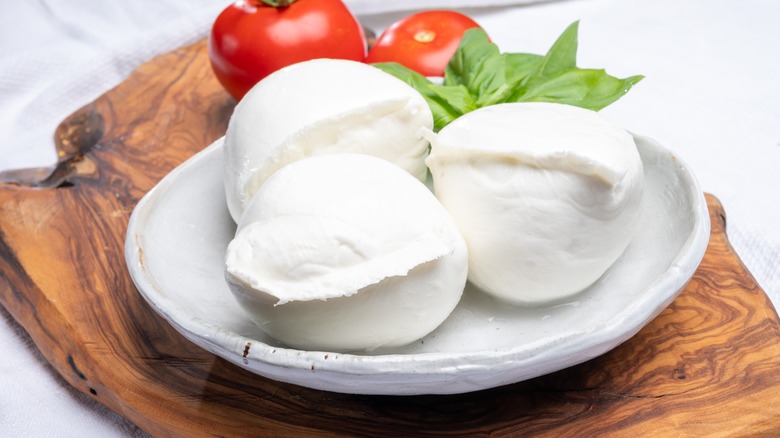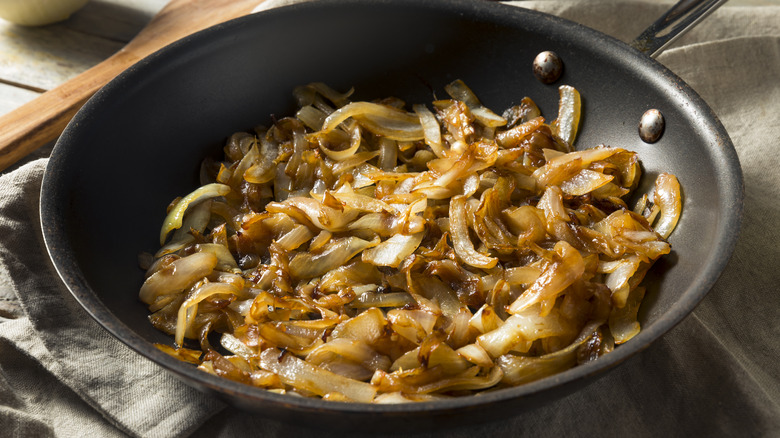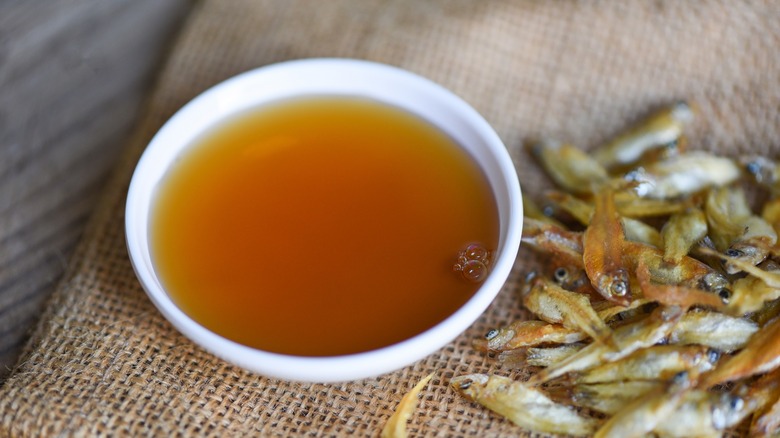23 Ingredients That Will Seriously Upgrade Your Tomatoes
Around the world, millions of people use tomatoes daily. Whether in jarred, canned, paste, or fresh form, the fruit is an essential stand-by in the kitchen and is highly prized for its ability to bring umami flavors to the table. When eaten on their own, tomatoes have an exciting balance of sweetness, savoriness, and tartness, which serves to wake up the palette when eaten as a simple, tasty snack.
However, anyone who's cooked with tomatoes will know that while they're good on their own, they're even better when combined with other foods. Tomatoes are a crucial element in countless recipes, with European, South American, Middle Eastern, and African cuisines (to name but a few) using them in a wide range of dishes. These recipes often utilize them alongside simple, easy-to-find ingredients that complement the surprisingly complex taste of tomatoes by adding balance and contrast. These ingredients can also change the texture of the tomatoes, creating an entirely new mouthfeel. Some more unexpected ingredients, meanwhile, can change up the flavor of your tomatoes in some out-of-this-world ways, and bring a new life to your favorite fruit.
1. Basil
Basil and tomatoes are a match made in heaven. Both of these plants are in season during the summer and flourish in warm environments. This has led to them becoming a common combination in many Mediterranean dishes, such as various soups. Basil and tomatoes are also an especially well-known duo in Italian cuisine, where you'll frequently find them adorning pizzas, stirred through pasta, and in salads.
The woodsy, floral notes of basil provide a perfect balance to the sweetness of tomatoes and take the edge off their acidity. Basil also has a pepperiness which offsets the sharpness of the fruit. While basil and tomatoes work excellently on their own, a third element, like olive oil, can bring together their flavors even further.
2. Balsamic vinegar
Splashing your tomatoes with some balsamic vinegar will brighten them up considerably. Unlike other vinegars, which tend to be sharper and more acrid, balsamic vinegar has a deep sweetness, with depth developed from its aging process in wooden casks. This aging can give it chocolatey, molasses-like, and smoky tones, which helps to offset the brightness of the tomatoes, rounding out their flavor.
To use balsamic vinegar with tomatoes, simply drizzle a little over some freshly cut slices. Using a balsamic glaze instead of vinegar will give them even more sweetness. Just make sure you don't cook with it: When you heat balsamic vinegar, it destroys its complexity, making it dull.
3. Pineapple juice
Pineapple juice may not be the first ingredient you reach for when cooking with tomatoes, but for out-of-season fruits, it's a must. The super-sweet, acidic notes of pineapple juice are surprisingly close to the taste of fresh tomato. When combined with slightly unripe pieces, it can help to round out their flavor and stop them from tasting flat and pulpy.
As such, pineapple juice is a great ingredient for salad dressings. It's even great when you're simply eating tomatoes on their own. Just be careful how much you add. Pour in too much, and your tomatoes will taste of pure pineapple. Instead, add about a tablespoon at a time, tossing the tomato thoroughly and taste-testing.
4. Flaky sea salt
Salt may not seem like a revolutionary ingredient to add to tomatoes. With these fruits, though, salt has a potent impact, as it helps to leach out excess moisture. Sprinkling tomatoes with some flaky sea salt will essentially begin to dehydrate them, concentrating their flavor and causing them to make your meals less water-logged.
Using flaky sea salt instead of regular table salt gives them a more delicate flavor, instead of the harsh, metallic brininess that free-flowing salt provides. It also allows you to better control the flow of the salt, stopping you from flooding the tomatoes with it unnecessarily. For the best results, add salt 15 to 20 minutes before cooking with them.
5. Worcestershire sauce
If you need to boost your tomatoes, Worcestershire sauce is the real deal. This classic British sauce is made with umami-rich fermented anchovies, and it has a sweetness and tartness to it that gives it serious depth. When it's added to a tomato sauce, it helps to deepen its flavor, balancing the acidity with its other dimensions and making everything taste next-level.
However, while Worcestershire sauce is most commonly used in cooked tomato recipes, you shouldn't discount its impact on fresh tomatoes. Adding a dash or two of it onto sliced tomatoes can give them instant zing. It's a particularly good ingredient to add if your tomatoes are slightly lacking in flavor, or aren't yet fully ripe.
6. Sugar
If you're making tomato sauce, you'll need to have sugar on hand. Tomatoes have an approximate pH level of 4.3 to 4.9, which makes them pretty acidic (for reference, that's a similar level to pickled cucumbers). This acidity tends to be higher when they're slightly unripe or have just turned red. When these tomatoes are added to a sauce, that sauce can become — surprise, surprise — pretty tart.
Adding sugar, however, helps to bring this tartness down, and accentuate the natural sweetness of the tomatoes. You can use any type of sugar, but white sugar will bring the most immediate sweetness. Just make sure you only add a pinch at a time, so you don't ruin your sauce.
7. Feta
Tomatoes go excellently with feta. This brined cheese — made with either goat or sheep milk — is renowned for its crumbly texture and sharp flavor. Its taste is determined by how it's processed, and the climate of its origin. Coastal feta is generally more herbaceous, and Central Greek feta has an unparalleled tang.
So, now that we know what exactly feta cheese is, how do you use it with tomatoes? Pretty much any way you like. Try crumbling it over some tomato soup, or stirring it into a tomato pasta. Or, simply slice it, and eat it alongside some raw pieces. The tanginess of the cheese serves as a perfect counterpoint to its umami-rich freshness.
8. Olive oil
Has there ever been such a classic food combo as tomatoes and olive oil? A mainstay of Mediterranean cooking, this duo serves each other perfectly, with the pepperiness of olive oil creating a delightful contrast to the tomatoes' sharpness. The smooth, glossy fattiness in the oil also helps to mellow out the brightness of tomatoes.
Using olive oil with tomatoes may also have some health benefits, thanks to the oil's ability to increase our ability to absorb lycopene, the antioxidant that gives tomatoes their red color. However, we're all about the flavors here. Cooking with olive oil can give your tomatoes a deep, mellow smoothness, whereas drizzling it onto fresh tomatoes allows you to enjoy their potent flavors immediately.
9. Garlic
When it comes to ingredients that bolster tomatoes, few do it as well as garlic. The allium provides a deep yet sharp flavor, which serves as a powerful undertone to the brightness of both raw and cooked tomatoes, and its natural umami amps up the savoriness.
Just be aware, though, that to unlock garlic's true potential with tomatoes, you'll want to cook it — using it raw will overwhelm the tomato flavor entirely. Roasted tomatoes with garlic, thyme, and olive oil, are a great way to bring the two flavors together. Roasting the tomatoes and garlic gives them a mellowness and emphasizes the umami, while the thyme and olive oil help to bring pepperiness and herbal notes.
10. Dried oregano
Dried oregano is the unsung hero of making tomatoes sing. With just a few shakes, this dried herb can give tomatoes a woody, fresh flavor and a newfound lease of life. When you're using fresh tomatoes, dried oregano pairs excellently: The best basic Greek salads have dried oregano and fresh tomatoes as two of their key ingredients, along with onions, feta, olive oil, and lemon juice.
This ingredient works just as well with cooked tomatoes and in tomato sauces, where it can provide the herbal notes that all good marinara sauces have. You can also use fresh oregano with tomatoes, but be aware that doing so will produce a different, slightly brighter taste.
11. Ricotta
Tomatoes and ricotta are a match made in heaven. Ricotta, an unripened cheese, has a gentle, creamy flavor that pairs seamlessly with the sharper notes of tomato. Because it's low in salt, its rich dairy notes shine through even more strongly. Its textural quality is also a serious strength when pairing it with fresh tomatoes, with ricotta's soft consistency serving to heighten the crispness of the raw fruit.
Ricotta also works excellently with cooked tomatoes. Try stirring ricotta into a tomato sauce to give it an added creaminess, and to mellow out its slightly acrid tones. The ricotta will melt into the sauce, giving you a smooth, luxurious result, which you can then stir hot pasta through.
12. Tahini
Tahini might seem like a strange choice to pair with tomatoes, but it makes more sense than you think. Tahini has a deeply nutty, rich taste and a creamy consistency, with a light hint of savoriness running through it. This richness helps to highlight the sharpness of tomatoes, while simultaneously stopping them from becoming too acidic-tasting. The gentle savoriness, meanwhile, underpins the umami flavors in the fruit.
To serve tahini with tomatoes, try first whipping it with some water and lemon juice. This will give it a pillowy quality and thicken it slightly. Spoon it onto a plate, and then top it with some freshly sliced heritage tomatoes, tossed in a simple dressing of olive oil, lemon, and garlic.
13. Baking soda
Baking soda can have a powerful effect on tomatoes. When added to a tomato sauce, a touch of baking soda transforms the mixture from something overly acidic into something rich, balanced, and flavorful. Baking soda is alkaline, with a pH level of 9, and this helps to counteract the acidic tomatoes. With this, a flavor balance is created: The tomatoes will no longer taste acrid and have a gentle sweetness.
The trick here, though, is not to add too much. Putting too much baking soda in food can give it a soapy, unappealing taste. Begin by adding a tiny amount, around ⅛ teaspoon, and then taste-testing your sauce. If you need more, add it a pinch at a time.
14. Parmesan
If you want to amp up the umami, reach for the parmesan. Parmesan has a high proportion of glutamate (an amino acid that is crucial to the production of a savory umami flavor). It's this amino acid that's also so abundant in tomatoes, and which contributes to their taste.
Combining the two, then, heightens the umami of both, and makes your tomatoes taste ultra-savory and rich. As well as this, the parmesan also brings saltiness to the table, boosting your tomatoes' natural flavors further, as well as a funky, cheesy note that works well with their freshness. Try grating some parmesan over fresh tomatoes, or cook them together by making baked tomatoes with parmesan and oregano.
15. Red wine vinegar
Not all types of vinegar go with tomatoes, but red wine vinegar is a crucial exception. This vinegar has a distinctly milder taste than white vinegar, meaning that it pairs more effectively with the already-acidic tomatoes. In addition, it has a grape-like fruitiness which gives tomatoes more complexity and rounds out their flavor.
To keep things simple, drizzle some red wine vinegar over sliced tomatoes, with a little olive oil and salt to bring everything together. Red wine vinegar is also a great choice in dressings for tomato salads. Red wine vinegar can also replace red wine in a tomato sauce, giving it a slight brininess, although don't add too much — things can get sour.
16. Everything bagel seasoning
It sometimes feels like the somewhat mysterious everything bagel seasoning goes well with everything — and it definitely goes with tomatoes. This blend of sesame seeds, dried alliums, salt, and poppy seeds has a delicious complexity and a balance of nutty and savory notes. It's these flavors that are lacking from tomatoes — and adding it to them can accentuate their freshness.
The best part about using everything bagel seasoning on tomatoes is that it's so simple: Just sprinkle it on top of some freshly sliced tomatoes layered onto some crackers, and you've got an easy snack. Or, pop some slices onto a bagel over some cream cheese, add some seasoning, and top it with grated parmesan.
17. Rhubarb
Rhubarb and tomatoes are surprisingly good friends. Rhubarb has a sweet and sour flavor compound, which is a natural fit for tomatoes. When the two are combined, the tomatoes' flavors are somehow accentuated, and the fruit tastes fresher, punchier, and deeper.
Combining rhubarb and tomatoes can be tricky, but the best way to do it is to combine them in a soup or stew. Throw a cup or two of diced rhubarb into your next tomato-based crockpot recipe, and watch it all come to life. Alternatively, you can pair the two in a salad, by first marinating the rhubarb in vinegar, oil, mustard, and garlic, and then tossing it with some chunky tomato pieces.
18. Pesto
Throwing pesto onto some freshly sliced tomatoes is an easy way to make a delicious snack. This Italian paste is traditionally made with basil, olive oil, pine nuts, and parmesan, and its combination of ingredients creates a savory, nutty, herbal flavor. All of these different taste components round out the flavor of tomatoes wonderfully, and somehow give them more body.
Although classic green pesto (Pesto Genovese) is the most common variety, there are lots of types of pesto you should know about that work well with tomatoes. Arugula pesto can provide pepperiness and a slight spice to your fruits. For deep umami, try Pesto Calabrese, made with roasted red peppers and tomatoes, spooned onto raw tomato slices.
19. Strawberries
Tomatoes and strawberries might seem strange on the surface, but pairing these two fruits together gives you an impressive combination of sweet and sour. Raw strawberries have a pH level of 3.5, making them more acidic than tomatoes. When paired together, they help to accentuate the tomatoes' brightness, while the umami flavor from the latter helps to deepen the strawberries' flavor.
To see this in action, try them in a tomato and strawberry salad. Combine sliced strawberries with a few different varieties of sliced tomatoes, each one providing its own flavor profile. Add a touch of balsamic vinegar to bring out each fruit's sweetness, and some olive oil to counterbalance the acidity with some peppery fats.
20. Mozzarella
When the first Caprese salad was thrown together on the island of Capri, little was it known that a classic food pairing was created forever. The creamy mozzarella in this salad is arguably the perfect counterbalance to the humble tomato, thanks to its rich yet subtle taste and mellow dairy notes. While regular cow's mozzarella will work just fine with tomatoes, high-fat buffalo mozzarella is even creamier, making the pairing even more dynamic.
There's also the texture combo to think about. Fresh mozzarella has a soft yet bouncy consistency, with just enough bite to stop it from being spreadable. This means that it holds its own against fresh, crunchy tomatoes while providing a pleasing contrast to them.
21. Caramelized onions
If you want depth with your tomatoes, hit them with some caramelized onions. The process of caramelization creates an almost absurdly rich flavor out of these simple vegetables, due to the conversion of sucrose into glucose and fructose caused by the cooking process. As a result, caramelized onions are deeply sweet and full of body, with a savory counterpoint.
All of these aspects work excellently with tomatoes, highlighting their bright, acidic flavors in loads of combinations. To keep things simple, caramelized onions spooned onto sliced tomatoes can make a great open-faced sandwich. Caramelized onions also make an excellent tomato soup bowl topper. Or, stir them into a bowl of pasta with tomato sauce for extra depth and mellowness.
22. Honey
Honey can bring out a tomato's flavors in some unexpected ways. Like simply sugar, honey has a balancing effect on tomatoes, helping to temper their acidic notes with sweetness. Honey, however, has a floral quality and a warmth that doesn't hide a tomato's acidity, but instead rounds it out, making it juicier.
Honey also helps to heighten the umami flavors in tomatoes, lifting them with its sweetness. Texturally, too, it delivers a silky-smooth coating to fresh tomatoes, which is particularly useful if they're a little firm. Honey is best enjoyed simply, with a quick drizzle over some summer tomatoes served as a snack. If you wish, you can also substitute it for sugar in tomato sauce.
23. Fish sauce
Of all the umami-filled ingredients that will easily boost your tomato sauce, fish sauce might have the most immediate impact. This thin, fermented sauce is a staple of Thai cuisine, and given its ability to provide intense savoriness instantly, we can see why. With tomatoes, fish sauce digs deep and lifts the fruit's umami notes higher than ever, producing an ultra-savory, slightly sweet result.
When using fish sauce in a tomato sauce, though, you need to act early. Adding it too late will give your sauce an unpleasant fish flavor. Add a few dashes of it as your sauce starts to bubble, and give it time to cook and mellow out, before adding more if you need to.
